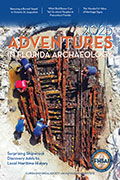
When it comes to learning about the very early Spanish period in Florida, nothing could be better than a contemporary history book, right? Well, almost contemporary such as the 1722 book on the right, found in the archives of the Library of Florida History. Sure, the Spanish were here from 1513 or so, but as Archivist, Ben DiBiase outlines in an episode of Florida Frontiers Radio (https://myfloridahistory.org/frontiers/radio/program/400 ) not much happened anyway. The main Spanish settlement, St. Augustine, was never more than a struggling, disease ridden and poorly supplied military outpost, with at most a few hundred residents. But surely the author and noted historian Andres Gonzalez de Barcia (d. 1743), one of the founders of the Royal Spanish Academy (https://www.inmsol.com/brief-history-royal-spanish-academy/ ), would know that and produce a definitive and useful tome.

Unless you happen to be less than fluent in classical Spanish.

Fortunately poet and translator Anthony Kerrigan ( 1918-1991) was up to the task, and his 1951 translation is also in the LFH archives.
What we find is more like a novel than a history book, with chapters by decade and sections for each year. Surly, this will be full of detail about life in Florida. Let’s pick a year, say 1619, made famous recently by the eponymous New York Times project (https://www.nytimes.com/ interactive/2019/08/14/magazine/1619-america-slavery.html ) on the beginning of slavery in what is now the United States.

Or, if you prefer:

And that is about it for St. Augustine, 1619, seen from a hundred years in its future. At least for this book.
Of course there are thousands of sources; official correspondence, ship manifests, personal letters and that old genealogical standby, church records. The Spanish (read Catholics) kept great records of everything church related. That could include almost anything, because the church, the government and daily lives were deeply intertwined. Most of the early records are preserved to this day in the Diocesan archives in St. Augustine. But, even better, they have been scanned and are on line through the University of Florida: (https://guides.uflib.ufl.edu/ColonialFlorida )
To bring this back to 1619 and the start of slavery in the English colonies, as Ben does in his segment, note that a form of slavery existed in the Spanish controlled areas 50 years sooner than farther north. As a practical matter, the search for slaves really ranked right up with gold and souls as a motivation for exploration and settlement. A difference, which may appear more significant now than it did to people living through it, was that the Spanish viewed slavery as a condition that could be changed; a result of class and circumstance more than of race. Enslaved people had some rights, some agency in the community that could lead to manumission. One route was to convert to Catholicism. Records of that still exist, too, and in fact you can find them at the Slave Societies Digital Archive ( https://www.slavesocieties.org/) housed at Vanderbilt University.







